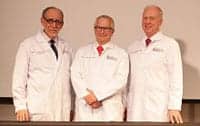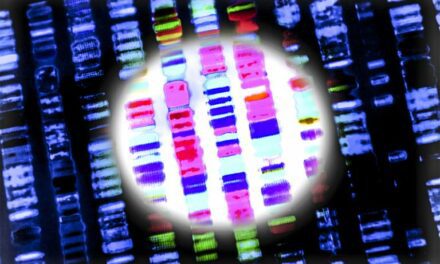As the potential use and benefit of next-gen sequencing becomes more evident, the arrival of this emerging technology and the resulting paradigm shift seem imminent.
By: RENEE DIIULIO
 |
| “The first phase of implementation for some emerging technologies does have a diagnostic focus, but there are certainly implications beyond diagnoses for some of these technologies,” says Alexander R. Judkins, MD, pathologist-in-chief at Children’s Hospital Los Angeles. |
The idea of the X-ray was imaginative. Its development was inventive. And the advances within the resulting field of radiology have been truly innovative. The immediate benefits have been obvious, but along with the medical answers provided has come significant change in the way patients have been assessed, diagnosed, and treated.
DNA sequencing holds the potential for a similar path and immense impact. The promise has been there for years, but the technology and the expense have presented formidable challenges for manufacturers and health care providers alike. The next iteration of the technology seems poised to deliver on the potential shift in paradigm that will truly enable precise diagnosis, personalized medicine, and preventive care.
Larger, specialized facilities are already beginning to implement the emerging technology. Typically the first to adopt new methodologies, these institutions tend to have the resources needed to make innovation a success.
Many are using the techniques and equipment on a research basis. As in most medical disciplines today, reimbursement has to follow proven value and precede wide adoption. But the value—with its potential for a positive impact on both patient care and economic efficiency—becomes more evident as more facilities begin to use next-generation sequencing (NGS) as a clinical tool.
The research they are conducting will be used to refine the routines, requirements, and restrictions associated with its use. And when the instrumentation is done “emerging” over the next 5 to 10 years, many predict that next-generation sequencing will replace today’s technologies, becoming the new gold standard.
“In the future, I can see that the application of next-generation sequencing for the diagnosis of genetic diseases in children and adults will find widespread use across clinical genetics labs,” says Avni Santani, PhD, scientific director, [removed]Molecular Genetics Laboratory[/removed], Department of Pathology and Lab Medicine, Children’s Hospital of Philadelphia, Philadelphia. “Genetic testing using NGS could be cost-effective, rapid, and comprehensive. Ten years from now, as the technology improves, sequencing the human genome could very well be a routine test. Every molecular genetics lab should be thinking about moving in this direction because Sanger sequencing is eventually going to be obsolete.”
Harder, better, faster, stronger
Sanger sequencing has served the medical community well, but next-generation sequencing promises to serve it even better. “There’s a unifying theme across the various technologies and platforms [in this field], and that is that they offer higher diagnostic yields compared to conventional methods,” says Alexander R. Judkins, MD, pathologist-in-chief, Children’s Hospital Los Angeles, Los Angeles.
This generally means that a diagnosis comes more quickly or with more information that can be used clinically to better care for the patient. With next-gen sequencing, both may be true, whether used to target specific gene panels or whole genomes.
Exome testing falls somewhere in between, focusing on the portion of the genome that is likely to yield useful genetic data while not restricted to a specific gene panel. All have their advantages and disadvantages, but whole exome and genome sequencing offer some shortcuts for complex cases.
First, they can save time. “With whole genome sequencing versus a targeted panel or even an exome, you can skip the enrichment step, which saves a substantial amount of time—several days,” says Carol Saunders, PhD, clinical lab director, Center for Pediatric Genomic Medicine, Children’s Mercy Hospital, Kansas City, Kan.
Newer technologies also speed the process. The laboratory at Children’s Mercy recently upgraded one of its instruments so that the sequencing step on that machine now takes about 25 hours—versus roughly 10 days.
Whole genome and whole exome sequencing can also help to reduce the amount of time to diagnosis through the acquisition of comprehensive data all at once, rather than in bits and pieces as negative results come back and further testing is required. “Whole sequencing is a lot faster than serial testing of individual genes one after the other,” Saunders notes, adding it can be less expensive as well.
“We’ve tallied the expense incurred by some of our families, and not even taking into consideration all the subspecialist visits, clinic visits, and other expenses, it’s pretty common to spend more than $20,000 in diagnostic testing procedures alone,” Saunders says. So even though testing a whole genome may be more expensive up front, it can be far more cost-effective over the long-term.
However, this does not mean that the technology is solely restricted to use in diagnosis. “The first phase of implementation for some emerging technologies does have a diagnostic focus, but there are certainly implications beyond diagnoses for some of these technologies,” Judkins says.
In the area of cancer, genetic mutations can help to identify which treatment path may have the 
Harder, costly, bigger, complex
Long-term cost savings are a benefit that will help to overcome the limitations to adoption. “There is an enormous cost to starting up a genome center, and there is the question of who will pay for it,” Saunders notes. Children’s Mercy performs its next-generation sequencing under a research protocol so testing is covered through grants, philanthropy, and hospital funds; patients are not asked to cover any portion of the cost.
“Other institutions that are offering clinical whole genome testing claim to have some success in getting insurance reimbursement, and when it becomes more mainstream and accepted by insurance companies, adoption will be easier,” Saunders says.
However, institutions will still need to secure the proper resources, which do not solely include equipment. Experienced laboratorians are needed to run the tests, geneticists are needed to interpret the results and counsel providers and patients, and management of the data requires significant expertise and equipment of its own.
“The amount of data generated by next-gen sequencing is unprecedented,” Santani says. Organizations need to ask themselves how they will store and process the data. Analysis and interpretation of large data sets, such as exomes and genomes, can potentially be a bottleneck.
Brains versus brawn
“The issue right now is more brains than brawn,” Arceci says. “The real key is not so much the technology, which has advanced faster than our ability to analyze the data, but the ability to perform the testing so that it is reproducible, done in a clinical-grade fashion, and applicable to patient care.”
Brains need to be applied in gathering the data, analyzing the data, and protecting the data. Currently, the field is in a constant state of flux. No straightforward guidelines have yet been established for laboratories to use. How is a test validated? How does one troubleshoot? Once the data is gathered, how is it analyzed? How is it reported? How is it explained?
Complicating matters further are the more complex questions surrounding the social and ethical implications of genetic testing. The analysis of whole genomes and exomes introduces the issue of incidental findings. Among the results, there is the potential to find not only the mutations sought to diagnose a patient’s genetic disease, but also to discover incidental findings, such as carrier status and adult-onset conditions. This, too, has both advantages and disadvantages.

How does a laboratory report these? Should it report these? Does it let the family decide? What results are even medically actionable?
“Sometimes, more information is not necessary or desirable, so methods to restrict and focus a test to answer a specific question are an important topic of discussion that are often defined locally within an institution, but are also being investigated on a national level among qualifying bodies to establish best practices,” Judkins says.
For instance, the American College of Medical Genetics and Genomics (ACMG) is working on development of guidelines in the area of medically actionable results and the National Human Genome Research Institute (NHGRI) is supporting a consortium of experts tasked with defining and developing recommendations for the associated social and ethical issues.
Right now, physicians and genetic counselors represent the front lines for educating patients regarding the information gathered and are often the ones to explain the issues surrounding incidental findings. Unfortunately, physicians don’t really know enough and geneticists are in low supply. So laboratories that are considering offering these tests need to be prepared to offer significant education to physicians and patients through pre- and post-counseling.
Breaking in and busting out
Despite the challenges, however, the medical community is excited about the technological breakthrough. “We’ve received requests to run samples not only from every subspecialty within our hospital, but also from people throughout the world,” Saunders says.
The potential is huge. Next-gen sequencing will not be able to answer all diagnostic questions (for instance, it can’t identify pseudogenes), but its potential application is very broad. Microbiology, virology, cytology, genetics, cancer cytogenetics—these are just examples of the fields and laboratories that may choose to implement the technology in the future.
Next-gen sequencing is likely to expand its role beyond diagnostics as well, impacting treatment and screening, perhaps even facilitating earlier (and potentially more effective) screening tests. “These kinds of approaches may eventually be used to screen very, very early in the pediatric window, or perhaps prenatal window, to allow the implementation and development of personalized health plans and approaches that are managed in conjunction with specialists and primary care physicians and executed with families over a lifetime,” Judkins says.
These ideas are imaginative, the ability to achieve them inventive, and the advances occurring now seem innovative enough to make the dream a reality. Will hospitals become places where patients go to prevent cancer rather than treat it? Will incidental findings become a savior or a scourge? The medical community isn’t certain yet how much the paradigm will shift when this emerging technology has fully arrived, but that it will shift is not a question.
Renee Diiulio is a contributing writer for CLP. For more information, contact Editor Judy O’Rourke, jorourke@allied360.com
Learn more about inroads being made by emerging technologies:
Phoenix Children’s Hospital Establishes Pediatric Institute of Molecular Medicine:
Boston Children’s, Life Technologies Form Claritas Genomics, a Clinical Genomics Co
Rapid Genome Test for Infants Developed By Children’s Mercy: One Of TIME’s Top Medical Breakthroughs 2012
BGI@CHOP Joint Genome Center to Offer Clinical Next-generation Sequencing Services




